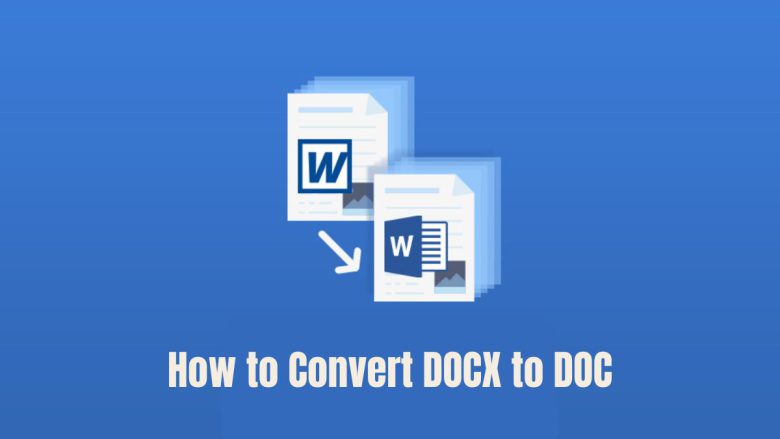
DOCX is now the standard format for word documents. This is thanks to its use in Microsoft Word 2007. However, there are still many situations where you might need to convert a DOCX file back to the older DOC format. If you need to work with legacy systems or share docs with older software, converting DOCX to DOC can help. It maintains compatibility.
This blog post will guide you through the process of converting DOCX to DOC using the free FileProInfo DOCX to DOC Converter. We’ll cover: why to convert, the differences in file formats, and a simple, detailed process to do it.
Understanding DOCX and DOC File Formats
What is DOCX?
DOCX is the modern file format for Microsoft Word documents, introduced with Word 2007. It’s based on the Open XML standard. It allows for better compression, a smaller file size, and better integration with other Office products. DOCX files are a ZIP archive of XML files. This makes them better and easier to use than older formats.
Key Features of DOCX:
- Open XML Format: This open standard ensures that DOCX files can be used across various applications, not just Microsoft Word.
- Smaller File Size: Thanks to its compressed structure, DOCX files take up less space compared to DOC files.
- Enhanced Features: DOCX supports a wide range of advanced features like embedded media, better image handling, and improved formatting capabilities.
- Cross-Platform Compatibility: DOCX can be opened and edited in modern word processors like Google Docs, LibreOffice, and Microsoft Word.
What is DOC?
DOC is the older Microsoft Word file format used primarily before the introduction of DOCX. It’s a binary file format that stores data in a less accessible structure compared to DOCX’s open XML format. While DOC is still supported by Microsoft Word, it lacks many of the advanced features that modern users have come to expect. DOC files are often larger in size and less efficient, but they still offer compatibility with older systems and applications.
Key Features of DOC:
- Binary Format: This format stores data in a non-compressed form, which makes DOC files larger in size.
- Legacy Compatibility: DOC is widely supported by older software and operating systems, which makes it a go-to format for those still using older technology.
- Limited Features: DOC doesn’t support some of the more advanced features that are standard in DOCX, like improved image handling and advanced document formatting.
Why Convert DOCX to DOC?
While DOCX is the more advanced and preferred file format today, there are still many reasons why you might want to convert it to DOC:
1. Legacy Compatibility
Older systems, software, or hardware may not fully support DOCX files. For example, if your company uses outdated word processors, you may have issues opening or editing DOCX files. Converting them to DOC ensures that they can be opened and edited without any compatibility problems.
2. Simpler File Structure
In some cases, the DOC format is simpler to use. This is especially true for those using custom tools, scripts, or macros made for the older format. Converting DOCX to DOC can make the file easier to handle and manipulate in these environments.
3. Broader Device Support
DOCX works with most modern devices and word processors. But, some niche devices and apps may only support the older DOC format. In such scenarios, converting your DOCX file to DOC will make sure it can be accessed on any device.
4. Document Recovery
Occasionally, if a DOCX file becomes corrupted or unreadable due to software issues, converting it to DOC can help recover the content. Since DOC uses a simpler structure, it can be easier to extract data from it in case of file corruption.
5. Editing Flexibility
Some users find the DOC format easier to edit. This is true for text-heavy documents that don’t need advanced formatting. If you need to perform basic edits or share a document in an environment where editing tools are limited, DOC might be the better option.
How to Convert DOCX to DOC Using FileProInfo
Now that you know the benefits of converting DOCX to DOC, let’s move on to a step-by-step guide for using FileProInfo to do the conversion. This free online tool offers an easy and reliable way to convert your files without the need to download or install any software.
Step 1: Visit FileProInfo’s DOCX to DOC Converter
To get started, head over to FileProInfo DOCX to DOC Converter. This online tool is free to use, and you don’t need to register or sign up. The interface is clean and straightforward, allowing you to convert your files quickly.
Step 2: Upload Your DOCX File
On the converter page, click the “Choose File” button to upload your DOCX file. You can also drag and drop the file into the designated area. FileProInfo supports files up to 150 MB, so you can easily convert large documents without any issues.
Step 3: Start the Conversion
Once your DOCX file is uploaded, click the “Convert” button to begin the conversion process. FileProInfo’s converter is fast and typically only takes a few seconds to convert even large files.
Step 4: Download Your DOC File
After the conversion is complete, a download link will appear. Click the link to download your newly converted DOC file. That’s it – your document is now in DOC format, ready to be opened and edited in older software versions.
Benefits of Using FileProInfo’s DOCX to DOC Converter
There are many reasons why FileProInfo stands out as one of the best online tools for converting DOCX to DOC:
1. Free and Easy to Use
FileProInfo’s converter is completely free, and you can convert as many files as you like without paying any fees. There’s no need to download or install any software – everything is done online.
2. Supports Large Files
FileProInfo allows you to convert files up to 150 MB, making it ideal for converting large and complex documents.
3. Quick and Efficient Conversion
The platform offers fast conversion speeds, meaning you won’t have to wait long, even for large files. The process is streamlined and takes just a few clicks.
4. High-Quality Conversion
Your document’s formatting, text, images, and other elements will be preserved during the conversion process. FileProInfo ensures that your newly converted DOC file retains the same quality as the original DOCX file.
5. Safe and Secure
All files uploaded to FileProInfo are handled with the highest level of security. We delete your documents from the server after conversion. This ensures your privacy and data protection.
Practical Applications for DOCX to DOC Conversion
While DOCX has become the standard, there are many real-world scenarios where converting DOCX to DOC can be useful. Here are some common examples:
1. Government Agencies
Many government departments still use older software and systems that only support DOC files. When sharing documents with such institutions, converting DOCX to DOC ensures seamless communication.
2. Educational Institutions
Schools and universities may still rely on older word processing systems that prefer DOC files. Converting assignments, reports, or syllabi from DOCX to DOC ensures everyone can access the documents without compatibility issues.
3. Corporate Environments
Some businesses, especially those with legacy systems, may need DOC format. It works better with their software tools. Converting DOCX files to DOC ensures compatibility and smooth workflow.
4. Legal Documents
Older law firms or legal departments may use software that is designed to work specifically with DOC files. Converting DOCX to DOC can be a necessity when sharing contracts, agreements, and other legal documents.
Common Challenges and How to Avoid Them
Although converting DOCX to DOC is generally straightforward, there are a few challenges that you may encounter during the process. Here’s how to avoid them:
1. Formatting Errors
One of the most common issues during conversion is minor formatting errors. While FileProInfo ensures high-quality conversion, some complex elements like charts or tables may not always transfer perfectly. After conversion, it’s always a good idea to review your document to ensure everything looks correct.
2. Compatibility Issues
Converting DOCX to DOC helps compatibility with older systems. But, some very old software might still struggle with modern elements in the document. Try simplifying the document before conversion to ensure smooth compatibility.
3. File Size
While DOCX files tend to be smaller, DOC files are generally larger due to their binary format. Keep this in mind if you’re dealing with file size limitations.
Conclusion
Converting DOCX to DOC is an essential process for anyone working with older systems, devices, or software. Use FileProInfo’s free DOCX to DOC converter. It will quickly convert your files and keep your documents’ quality.
This guide has made the conversion process simple and easy for students, professionals, and corporate workers.
Start converting your DOCX files today and experience the benefits of broader compatibility and ease of use.


